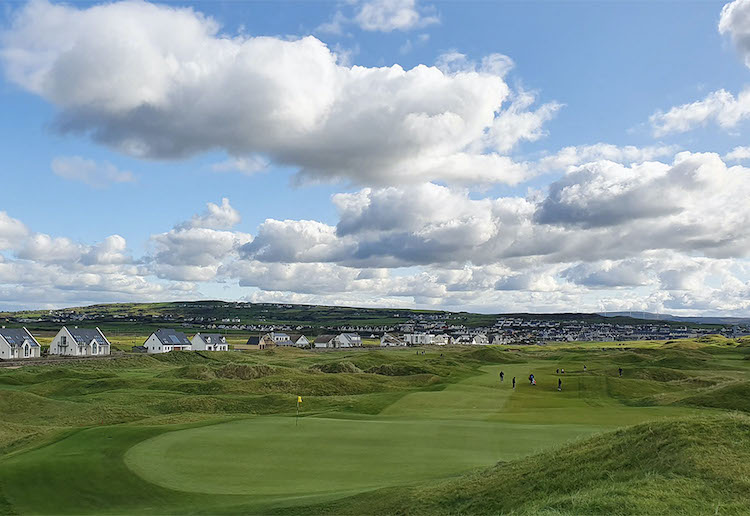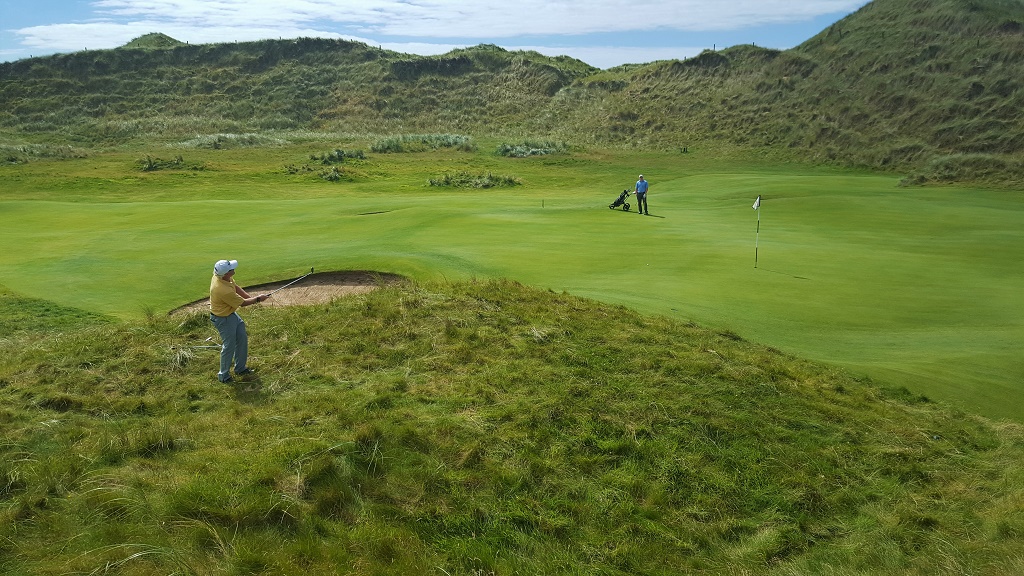
The meanness of Links Fescue! Nasty Fescue!
True links golf courses are a rare commodity in North America and it is estimated that the percentage number of true links golf courses in North America is less than 1%. Namely, in the USA, the closest to a true links golf courses are known to be Highland Links, Pebble Beach, The Bandon Dunes Courses, Whistling Straights and further up the coast to Cabot Links. Notably, it is suggested by various authors that there are 246 true golf links courses worldwide. Whereas, Scotland, England, Ireland & Wales have 210 courses out of 246. (Information dated from 2017).
The beauty of playing links golf is that there are no tree-lined fairways to deal with. Therefore, golfers can spend less time hacking out from underneath the trees. Also, golfers can see the location of most hazards on the parkland golf courses. However, this is not the case with the links golf course. Mostly, links courses are designed with deep & nasty bunkers, tight fairways, hills and mounds to hit over or use to play better shots, various types of long & short grasses, thick heather & so on.
Also, some parts of the hole might not be able to see clearly until the hole is finished. Then, there are the on-course blind shots. A blind shot is where simply golfers can see where the target is. Blind shots are difficult to play because golfers can’t see the ball bouncing. Therefore the shot can feel like a hit and hope for the best.
The Bunkers!
Golfers beware of the dangerous deep bunkers. Bunkers are placed on the links to catch the wayward running ball and bunkers are simply treacherous. I am not talking about a fairway or a greenside pot bunker with a lip of 6/7 feet high or less. I am talking about the deep bunkers, such as the mine of a fairway bunker on the 6th hole at Lahinch Golf Club. Also, the Big Bertha bunker on the 17th Hole at Royal Portrush. Then there is Hell bunker at St Andrews Old Course. Beware and keep the ball out of such bunkers at all costs! Furthermore, the really deep bunkers are simply, just score wreckers!
Traditional Blind Shots!
Blind shots seemed to part and parcel of the older style golf links designed course. I suspect if golf course architects from the 19th century had the current machinery at their disposal. Would they have created a completely different type of hole to the blind holes? Take the 5that Lahinch (the dell) par 3, or the tee shot on the 9th at Royal County Down? Not to forget the par 3 up the hill the Himalaya 5th at Prestwick? Also, Crunden Bay’s Blin Dunt! But, if you had the opportunity to rebuild these holes would you take a bulldozer and reshape the hole so that you see the green?
Some holes that are blind shots will have a rock or a stick to marking the line for that shot direction. The Dell hole at Lahinch uses a white rock to mark where the flag is located on the green. Whereas, the 10th hole at Royal County Down uses a large poll to guide tee shots over that dune to the fairway. Other blind holes might suggest hitting the ball towards landmarks in the distance. It is hard to believe sometimes that this is the way to play the hole. But, trust the line and play it.
Links Fescue
Finally, the toughest part of the links is playing from the “rough” or otherwise know as long/tall/short fescue & marram grass. But, how rough is rough? It is easy to lose a ball in the fescue, and the ball tends to sit down to the roots of the grass in the rough, The rough is like a mesh of wire that grabs and twists the clubhead if you swing the clubhead too hard at the ball. Therefore, swing the club softly and or play the rough shot like a fairway bunker shot (catch/hit the ball cleanly). On the other hand, when the ball sits up on tight lies which can be difficult to chip off.
For the most part, if you hit the ball into the rough and you or the caddy did not see the ball bouncing? Then, in the interests of keeping play moving, I would suggest reloading and hit again. The hardest part of a links golf course is playing from the rough. I would suggest keeping your sand wedge or lob wedge ready to hand to hack your way back to the fairway.

Friendly Special Advice!
Have you ever received specific advice on how to play the links golf from your fellow buddy golfers? Mainly, after they have spent a week or two playing links golf all over Scotland and Ireland? Such as, “I love links golf, you need to be able to play the low shots and the chip & run shots. Then land the ball short of the green to bounce and run the ball onto the green up to the flag”. That is good advice; however, all those shots were easily learnt if you were a lucky boy or girl growing up on the links.
However, as golfers, we must try to play such shots. To practice low shots, I would suggest practising hitting half swings with your 7 to 4 irons. Also, practice chip and run shots with your utility club. As a PGA golf coach, I find that this is a good shot to play from 5 to 15 yards from the green.
My golf pro’s two cents of advice:
My two cents of information to golfers playing links golf for the first time. “Play the ball to where you can see land” and “keep the ball in play, a simple 150 – 200 yards shot with a bounce and roll is quite effective!”. Trust the caddy lines off the tee and he or she will keep you out of the links fescue.
Also, Or you might hear a caddy say “there is dead ground between you and the flag, play the yardage”, which means that you can see the flag, but you can’t see all the terrain between you and the flag. The “dead ground” can trick a golfer’s eye into believing the target looks closer than the calculated yardage. The “Dead Ground” casts dough into the golfer’s mind as he or she is picking the club to play the shot. In mild terms of what should you expect playing links golf? Play the course and see what happens, take notes of the shots you did not play well and learn how to play those shots better!
In mild terms of what should you expect playing links golf? Play the course and see what happens, take notes of the shots you did not play well and learn how to play those shots better!
Enjoy golfing in Ireland or Scotland, 2017.
- John Dooley Concierge Golf Ireland. The meanness of links fescue. Contact us by CLICKING HERE
- Also, Click here to view more information about Golf Trips to Ireland.
- Please, Click here to learn more about Tom Doaks Confidential Guide to Golf Courses.
